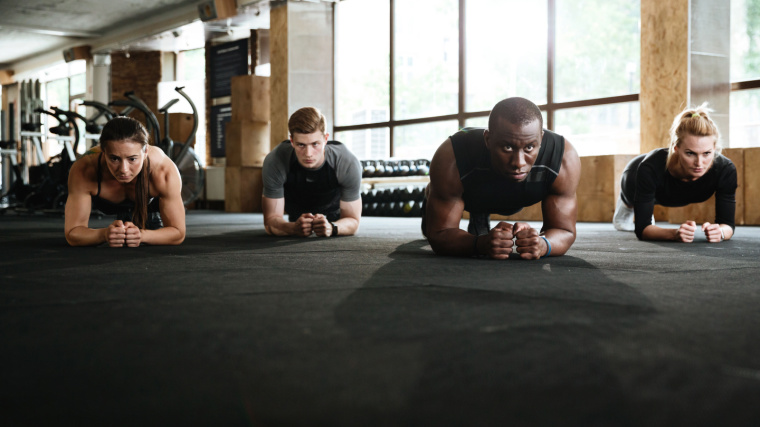Bulking is a two-step process. Step one; eat more. Exactly how much more varies, of course, and perfecting your bodybuilding meal prep is a science worth exacting to the letter.
But once you’ve determined how many grams of protein you need, how hard you’re loading up on healthy carbs, and what the best bodybuilding supplements might be, the real battle begins: Crafting your plan of attack in the weight room.

Your workout routine for bulking up shouldn’t just be more of the same. Sure, more food means more energy, but things are never that simple. To ensure you’re building as much muscle as possible and getting the most bang for your buck, you need a rock-solid bulking workout plan that will build muscle safely and sustainably. You’ve come to the right place.
What Is Bulking?
“Bulking” is a bit of gym slang that refers to a period of intentionally consuming more calories than you require in order to gain weight. The sport of bodybuilding is cyclical — hobbyists and pro competitors alike move through different seasons throughout the year. They build heaps of muscle during a bulk, shave off any spare fat they’ve picked up by following a “cutting” diet, and repeat this process.
When it comes to bulking workouts, things get a bit more complicated. An increase in energy availability (that is, you have more calories to work with) necessitates a few changes in how you should approach your workout. After all, you have more resources on hand, so you should put them to good use.

[Read More: Strongest Pre-Workouts]
In real-world terms, most bulking workout plans contain higher volume (as in more sets), more diverse exercise selection (using a variety of workout machines), and the tactical inclusion of some high-intensity training techniques like drop sets or forced reps.
Cutting vs. Bulking: Training Differences
Old-time bodybuilding dogma once preached that muscle hypertrophy is a binary — an on-off switch that flips based on your nutritional behaviors. If you’re in a calorie deficit with low energy availability, you have no shot of adding muscle mass, so don’t push it too hard in the gym.
Modern scientific literature has refuted this idea, at least in part. Studies have shown that you certainly can build muscle while cutting, though admittedly it is much less feasible than when you’re bulking up. (1)(2)
So while you don’t generally have enough gas in your tank to slam dozens of difficult sets per workout on a cut, think of your bulking workouts as simply dialing most elements of your training up a notch and including some new ingredients.
How to Train on a Bulk
In bodybuilding sport science, training volume is generally regarded as the most important knob to turn for long-term outcomes like building muscle. More calories at your disposal means you have the freedom to perform more work in the gym, which should create more muscle growth.
However, this only works up to a point. There’s such a thing as a “minimum effective dose” of strength training, which refers to the least amount of exercise you can do and still build meaningful amounts of muscle. That’s a great place to start on a cut when your recovery is limited, but on a bulking plan, you should err closer to your “maximum recoverable volume.”
Your Bulking Workout Plan
The current consensus among the scientific community is that, for most folks, the number of sets and reps you should do per muscle group, per week, falls between 10 and 20. (3) This isn’t a hard and fast rule, but it should serve as a starting point for you to then tweak and fiddle with over the course of your bulk.
How you divide up your overall training requirements is up to you. If you have the time, there’s no reason you couldn’t train all your muscles over the course of three days. Most commonly, though, a bulking regime consists of four or, most often, five workout days.

[Read More: 5 Great Bulking Foods for Digestion, Intra-Workout, and More]
This allows you adequate time to give direct attention to every muscle in your body. Here’s how that might shake out in practice:
- Day One: Chest, Back, Arms
- Day Two: Legs, Shoulders, Abs
- Day Three: Chest, Back, Calves
- Day Four: Legs, Abs
- Day Five: Shoulders, Arms, Calves
This may sound like a lot of work on certain days, and to be fair, it is. Bear in mind that a leg workout needn’t consist of 10+ hard sets of compound exercises in order to be effective.
The reason some of these workout days contain multiple muscle groups is because scientific research has pretty firmly concluded that training a muscle twice per week is superior to only hitting it once every seven days. (4)
The amount of work you perform and how many “doses” you divide that weekly volume into, though, are some of the only hard-and-fast rules for bulking training. Once you have those nailed down, the specifics are up to you.
The exercises you perform during a bulk should be comfortable, sustainable, and enjoyable. A good bulking plan should be plug-and-play: Pick from an assortment of movements, use different kinds of equipment, and go to town.
Chest
Chest training begins with the bench press, sure, but you’re going to have to hop off the bench if you want to maximize your chest growth. Your chest exercises should contain one or two pressing moves (ideally with different equipment or from a different angle) and one flye movement at least:
- Flat Barbell Bench Press
- Incline Barbell or Dumbbell Bench Press
- Decline Bench Press
- Chest Press Machine
- Weighted Dip
- Weighted Push-Up
- Dumbbell Flye
- Cable Flye
- Pec Deck or Machine Flye
Back
Your back consists of a wide array of different muscles, each with its own unique structure and function. To train your back comprehensively, then, you need a large assortment of pulling exercises. Select one horizontal pull, one vertical pull, and one upper-back-specific movement to build your bulking back workout around:
- Barbell Row
- Dumbbell Row
- Seal Row
- Hammer Strength Row or Pulldown
- Seated Cable Row
- Lat Pulldown
- Weighted or Assisted Pull-Up
- Weighted or Assisted Chin-Up
- Dumbbell Pullover
- Straight-Arm Pulldown
- Face Pull
- Rear Delt Flye
- Upright Row
- Barbell or Dumbbell Shrug
“Horizontal pulls” refer to the orientation of your body. When you perform a pulling movement while hinged over, torso parallel to the ground, you’re doing a horizontal pull. Same idea holds up for vertical pulls, where your torso remains erect throughout.
Legs
Leg training separates the wheat from the chaff in the gym, and a good leg workout for bodybuilding consists of challenging (and meaningful) exercises that work your quads, core, and posterior chain alike.

[Read More: Best Mass Gainers]
For your bulking leg workout, select one bilateral squatting movement, a hinge exercise of some sort, and a single-leg exercise of your choice. Then, finish up with machine isolation movements as needed.
- Barbell Back or Front Squat
- Leg Press
- Hack Squat
- Stiff-Legged Deadlift
- Romanian Deadlift
- Hip Thrust
- 45-Degree Back Extension
- Bulgarian Split Squat
- Step-Up
- Walking Lunge
- Reverse Lunge
- Lateral Lunge
- Cable Glute Kickback
- Leg Extension
- Leg Curl
- Hip Adduction
Biceps
Good biceps training is more about effort than equipment. Sure, there’s nuance to your exercise selection, but your biceps are a single-function muscle that really only serve to bend your elbow. As such, you can pick whatever biceps curl variation you enjoy the most.
[Read More: The 8 Best Biceps Stretches to Support Long-Term Arm Thickness and Strength]
For maximal biceps growth, select at least one movement where your upper arm is fixed behind your torso, like an incline dumbbell curl, and one with your arm in front like a preacher curl. Perform two or three biceps exercises in total, depending on how much of your weekly volume you’re doing in that session.
- Barbell Curl
- Cheat Curl
- Dumbbell Curl
- Hammer Curl
- Reverse Curl
- Preacher Curl
- Concentration Curl
- Incline Dumbbell Curl
- Spider Curl
- Bayesian Curl
- Zottman Curl
Triceps
Much like your biceps, your triceps are mostly designed to move your elbow joint, but there’s a bit more going on under the hood than that. The long head of your triceps connects to your shoulder blade, so the position of your shoulder will affect triceps engagement to a degree.
Perform at least one overhead triceps exercise to isolate the long head and ensure a comprehensive stimulus.
- Skull Crusher
- JM Press
- Close-Grip Bench Press
- Dumbbell Triceps Kickback
- Cable Triceps Pressdown
- Cable Overhead Extension
- Single-Arm Overhead Extension
- Dip
Shoulders
Your shoulders consist of three distinct regions, each with its own dominant function. You need a three-pronged approach to your shoulder training for muscle growth as a result: A pressing or front raise movement for the anterior section, a lateral raise for your side delts, and some type of rear raise or flye for your posterior deltoid. One exercise for each movement pattern should do the trick.
- Barbell Overhead Press
- Barbell Push Press
- Seated Dumbbell Shoulder Press
- Arnold Press
- Machine Shoulder Press
- Dumbbell Front Raise
- Dumbbell Lateral Raise
- Dumbbell Rear Lateral Raise
- Y-T-W Raise
Abs
Despite what you may see on a magazine cover or being spouted by your favorite fitness influencer, there’s nothing magical about ab training; your abs are a muscle like any other and they respond to proper stimuli all the same.

[Read More: The 6 Best Leg Extension Machines]
For comprehensive abdominal training, select one exercise during which your trunk moves like a crunch, one where your pelvis moves like a leg raise or V-up, and one isometric exercise for stability like a plank variation or rollout.
- Crunch
- Cable Crunch
- Machine Crunch
- Decline Crunch
- Hanging Leg Raise
- V-Up
- Dragon Flag
- Side Plank
- Plank
- Ab Wheel Rollout
Calves
Calves probably aren’t your favorite muscle group to train, but they’re as important as any other for developing your physique. Luckily, calf training is profoundly simple — perform a calf raise with your leg straight, and one with your knee bent, and you’re all set.
- Standing Calf Raise
- Donkey Calf Raise
- Seated Calf Raise
The Program Explained
Now that you have your training schedule laid out and more exercise options than you know what to do with, it’s time to put pen to paper and actually draft the routine. You have plenty of freedom to design your workouts however you like, but a good place to start is to perform large, multi-joint movements first while you’re fresh before moving onto the isolation exercises that follow.
[Read More: Get Freakishly Strong With the 5×5 Workout Program]
For example, with these principles in mind, the leg-shoulder-abdominal day might look something like this:
- Back Squat: 3 x 6
- Romanian Deadlift: 4 x 8
- Bulgarian Split Squat: 2 x 12
- Leg Curl: 2 x 15
- Dumbbell Shoulder Press: 3 x 8
- Dumbbell Lateral Raise: 4 x 12
- Y-T-W Raise: 2 x 10 reps each
- Cable Crunch: 4 x 8
- Hanging Leg Raise: 2 x 12
- Side Plank: 2 x maximum duration
If you performed this workout (which should last between 90 minutes and two hours, depending on how long you rest between sets) twice per week, you’d rack up 10 sets of quad training, 12 sets of hamstring and/or glute work, 18 sets of shoulders, and 12 sets of abdominals. Add or subtract sets as needed to focus on your weak points.
Diet & Supplements
A damn-good bulking routine won’t do diddly squat if you aren’t being equally studious in the kitchen. For its part, supplementation can enhance an already-solid dietary plan. Popular bodybuilding supplements for muscle growth include:
- Whey protein powder
- Creatine monohydrate
- Caffeine
- Branched-Chain Amino Acids (BCAAs)
Whether you’re following a pre-written meal plan under the guidance of a coach or you subscribe to the flexible dieting or IIFYM philosophies, your nutritional benchmarks need to be consistently on point to gain muscle.
[Read More: Best Protein Powders]
How much protein and how many calories you need are individual decisions based on factors like financial freedom, time available to cook, and the rate of weight gain you’re comfortable with. For a successful, sustainable bulk, start by hitting these major touchstones and tweak as needed:
- 200 to 500 extra calories per day above your maintenance
- .8 to 1.2 grams of protein per pound of body weight
- .3 to .5 grams of dietary fat per pound of body weight
- Fill in the remainder of your caloric capacity with carbohydrates, or add more protein or fat if you so choose.
While you can certainly follow a low-carb, paleo, or ketogenic diet and still make gains, most contemporary literature on bodybuilding diets regards carbohydrates as highly important to fuel your high-volume weight training sessions. (5)
FAQs
If your bulking plan still has you scratching your head, these common questions might help put some of those anxieties to bed.
Bulking is a slow and sometimes arduous process, especially for gymgoers who have several years of training under their belt already. If you’re brand new to resistance training, you can definitely expect to see some visual changes in just four weeks, but your rate of muscle gain will slow somewhat the longer you dedicate yourself to the gym.
A good bulking workout routine is anything that allows you to train all of your major muscle groups, either directly or indirectly, twice per week. You should aim to carry out between 10 and 20 challenging sets for your muscles in a week’s time.
A positive energy balance is mandatory for gaining meaningful amounts of muscle mass. To bulk up, you should eat above your caloric maintenance level on a daily basis. However, the more calories you consume, the higher your likelihood of putting on body fat will be. Most people do just fine with a moderate caloric surplus of 2 to 300 each day.
The amount of weight you gain each month is a personal decision — if you’re tracking your nutrition diligently. You can gain quite a bit of weight quickly if you throw caution to the wind and consume as many calories as humanly possible (called a ‘dirty bulk’), but some or even most of that weight will be new body fat.
Broadly speaking, a solid rate of lean muscle gain in your first year or two of training would be between .25 and 1 pound per month, with the upper range being considered extremely productive.
References
- Slater GJ, Dieter BP, Marsh DJ, Helms ER, Shaw G, Iraki J. Is an Energy Surplus Required to Maximize Skeletal Muscle Hypertrophy Associated With Resistance Training. Front Nutr. 2019 Aug 20;6:131. doi: 10.3389/fnut.2019.00131. PMID: 31482093; PMCID: PMC6710320.
- Schoenfeld BJ. The mechanisms of muscle hypertrophy and their application to resistance training. J Strength Cond Res. 2010 Oct;24(10):2857-72. doi: 10.1519/JSC.0b013e3181e840f3. PMID: 20847704.
- Schoenfeld BJ, Ogborn D, Krieger JW. Dose-response relationship between weekly resistance training volume and increases in muscle mass: A systematic review and meta-analysis. J Sports Sci. 2017 Jun;35(11):1073-1082. doi: 10.1080/02640414.2016.1210197. Epub 2016 Jul 19. PMID: 27433992.
- Schoenfeld BJ, Ogborn D, Krieger JW. Effects of Resistance Training Frequency on Measures of Muscle Hypertrophy: A Systematic Review and Meta-Analysis. Sports Med. 2016 Nov;46(11):1689-1697. doi: 10.1007/s40279-016-0543-8. PMID: 27102172.
- Iraki J, Fitschen P, Espinar S, Helms E. Nutrition Recommendations for Bodybuilders in the Off-Season: A Narrative Review. Sports (Basel). 2019 Jun 26;7(7):154. doi: 10.3390/sports7070154. PMID: 31247944; PMCID: PMC6680710.
Featured Image: Nikolas_jkd / Shutterstock